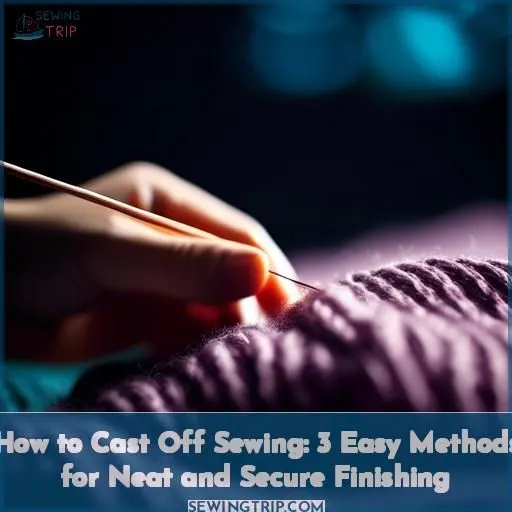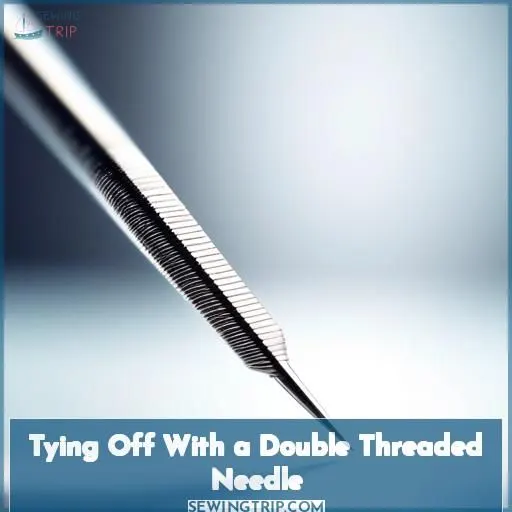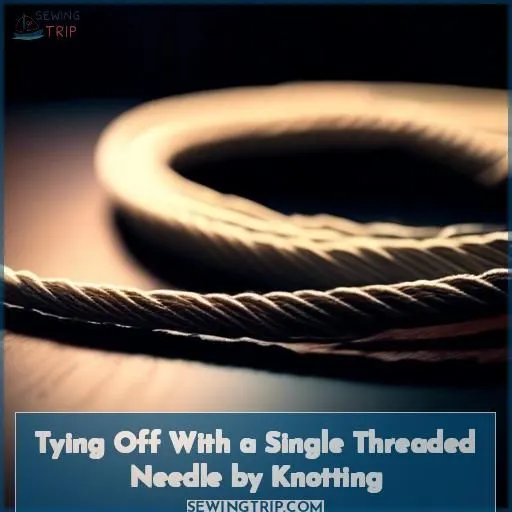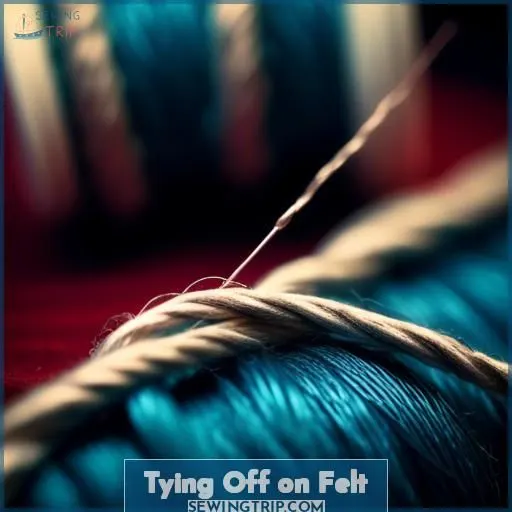This site is supported by our readers. We may earn a commission, at no cost to you, if you purchase through links.
To cast off sewing, you’ll want to tie off securely.
For a double-threaded needle, cut below the eye, leaving 2-3 inches, then tie three knots – tighten the first gently, then the rest firmly.
With a single needle, leave 3 inches, loop and knot the thread, guiding it into place before trimming.
On felt, tie a knot against the surface, insert the needle between layers, tug to tighten and embed the knot before trimming.
Proper knot tightening and placement ensure a polished, unraveling-free finish.
Want to explore more tidy cast off techniques?
Table Of Contents
Key Takeaways
- Tie knots securely to prevent unraveling and ensure a polished finish.
- Use appropriate knot techniques for different fabrics and applications.
- Practice knotting consistently for a uniform look in sewing projects.
- Test knot strength and durability before committing to a final project.
How to Cast Off Sewing?
To cast off sewing, you can use the sewn cast off method. This involves measuring a length of yarn about three times the length of the edge you’ll be casting off, threading your sewing needle with the yarn, and then inserting the needle purlwise into the first two stitches, pulling the yarn through both stitches, and leaving them on your knitting needle. Then, insert your sewing needle knitwise through the first stitch, pull the yarn through the first stitch, and drop only this stitch off of your knitting needle. Repeat these steps until only one stitch remains on your knitting needle, and then insert your sewing needle purlwise into the last stitch, pull the yarn through, and drop the stitch off of your knitting needle. This method gives a bit of stretch to the hem of your projects.
Tying Off With a Double Threaded Needle
You’ll begin by cutting the thread below the needle’s eye, leaving the two halves dangling. Next, make sure to leave 2-3 inches of thread to work with, as this length will make tying easier; then, tie three knots, gently tightening the first to prevent puckering while firmly securing the subsequent two.
Cut Thread Below Needle and Tie Halves Together
To tie off with a double threaded needle, first cut the thread below the needle and tie the halves together. Leave 2-3 inches of thread for easier tying.
Then, tie three knots, tightening the first knot gently to avoid puckering while tightening subsequent knots tightly.
For a single threaded needle, knot the thread and guide the knot into the desired place. Trim excess thread.
On felt, tie a knot against the felt, insert the needle next to the knot, and pull the thread to tighten before snipping.
Leave 2-3 Inches of Thread for Easier Tying
To guarantee a clean and safe finish, leave 2-3 inches of thread for simpler tying when ending with a double threaded needle.
This excess length enables better handling and accuracy in knot positioning, which is essential for tension regulation and avoiding gathering.
Keep in mind, the needle length and thread thickness should be suitable for the fabric type.
The knots should be tied tightly to secure the seam.
Additionally, when tying off on felt, it’s important to tighten the first knot gently to avoid distorting the felt.
The thread end will shrink back inside the felt when trimmed.
Tie Three Knots
Tying off with a double threaded needle involves several steps to guarantee a secure and strong finish.
First, cut the thread below the needle and tie the halves together.
Leave 2-3 inches of thread for easier knotting.
Then, tie three knots, ensuring that the knots are positioned correctly and of appropriate size.
Tighten the first knot gently to avoid puckering, and tighten subsequent knots firmly.
This method is suitable for items requiring stretch and was developed by Elizabeth Zimmermann.
Tighten First Knot Gently to Avoid Puckering
After you’ve tied your first knot, it’s essential to gradually increase the tension. Imagine it as the first encounter with your summer jute tee knitting pattern – you don’t want to startle it by being too forceful! Carefully tightening this initial knot guarantees that your project stays as sleek and supple as a long-tail cast-on, without any unwanted puckering.
Tighten Subsequent Knots Tightly
Tightening subsequent knots securely is essential for a reliable finish when tying off with a double threaded needle. Here are four key points to guarantee knot strength, appearance, and aesthetics:
- Knot Placement: Gently tighten the first knot to prevent puckering, but firmly tighten subsequent knots to hold the stitches in place.
- Knot Strength: Tighten the first knot sufficiently to reach the fabric’s edge, while subsequent knots should be pulled taut.
- Knot Appearance: Be aware of the knot’s position on the fabric, as it may be noticeable depending on the stitching method.
- Knot Aesthetics: Practice tying knots consistently to maintain a uniform look in your sewing projects.
To tighten subsequent knots, follow these steps:
- Tie a knot with the double threaded needle, leaving 2-3 inches of thread for easier tying.
- Gently tighten the first knot to avoid puckering.
- Firmly tighten subsequent knots to hold the stitches securely.
- Trim excess thread once the knots are tied.
Tying Off With a Single Threaded Needle by Knotting
To tie off with a single threaded needle by knotting, leave about three inches of thread for knotting purposes. Loop the thread to form a knot, hold the loop down with your finger as you tighten it, carefully guide the knot into the desired position, and trim away any excess thread.
Leave Three Inches of Thread for Knotting
To guarantee a tidy and stable completion when tying off with a single threaded needle by knotting, reserve three inches of thread for knotting.
This length enables proper tension management and knotting method, which is vital for yarn thickness and fabric kind.
Recall to hold the loop down with your finger while tightening.
Direct the knot into the preferred location.
Trim surplus thread.
Loop Thread to Make a Knot
To circle your line and make a knot, first make sure you have the right circle size for your line thickness and knot power. The knot place and stitch measure are key for a nice and tight finish. Here’s a simple 4-step guide:
- Make a circle with your line, thinking about the circle size and line thickness.
- Hold the circle down with your finger for better control.
- Tighten the circle to make the knot safe.
- Guide the knot into the place you want on your cloth, making sure it’s finished nicely.
Hold Loop Down With Finger While Tightening
Now, let’s move on to the next step in tying off with a single threaded needle by knotting.
After looping the thread to make a knot, grip the loop firmly with your finger to maintain control over the yarn and tension.
This needle grip is essential for precise stitch placement and loop sizing.
Adjust the tension as needed for a secure finish, ensuring that the knot sits nicely in its desired place.
Guide Knot Into Desired Place
To guide the knot into the desired place when tying off with a single threaded needle by knotting, follow these steps:
- Hold the loop down with your finger: As you begin to tighten the knot, hold the loop down with your finger to make sure that the knot is formed correctly.
- Guide the knot into place: Once the knot is formed, gently guide it into the desired location on your fabric. This can be done by pulling the thread in the direction you want the knot to go.
- Trim the excess thread: After the knot is in place, trim the excess thread to a manageable length. Be careful not to cut the thread too close to the knot, as this may cause the knot to unravel.
Remember to use the appropriate knot technique for your specific project, as different knots may be more suitable for various fabrics and applications. For example, an overhand knot is useful for securing fringe on a scarf or rug, while a square knot is commonly used in weaving. Always test the knot’s strength and durability before committing to a final project.
Trim Excess Thread
Now that you’ve secured your knots, it’s time to trim the excess thread. With sharp scissors, cut the thread to the desired length. Be sure not to leave too much thread, as it may fray and weaken the knot’s security. Dispose of the excess thread properly, and your cast-off is complete.
Tying Off on Felt
To secure your stitches on felt, start by tying a knot directly against the felt surface. Next, carefully insert your needle next to the knot, guiding it between the felt layers, and pull the thread taut to embed the knot inside the felt, trimming the tail.
Tie a Knot Against the Felt
To tie a knot against the felt, follow these steps:
- Start by tying a knot on the wrong side of the felt, making sure the knot is securely against the fabric.
- Next, insert the needle next to the knot and bring it out in the middle of the felt between the layers.
- Pull the thread to tighten the knot and trim off the excess thread.
- The thread end will shrink back inside the felt, creating a neat and secure finish.
This method is ideal for tying off threads when working with felt, as it ensures a strong and durable bond between the layers.
Pull Thread to Tighten and Snip
To tighten the thread on felt, first tie a knot against the felt. Then, pull the thread to tighten it and snip off the excess. The thread end will shrink back inside the felt, ensuring a neat and secure finish.
Thread End Will Shrink Back Inside the Felt
Once you’ve pulled the thread tight and snipped it close to the felt, you’ll notice a bit of magic. The thread end has a tendency to retreat back into the cozy embrace of the fabric layers, becoming nearly invisible. This neat trick helps prevent any unruly shrinkage or unsightly tails from marring your masterpiece.
- Thread retreats into felt
- Invisible finish
- Prevents shrinkage
- No unsightly tails
- Fabric layers conceal thread
Frequently Asked Questions (FAQs)
How do I prevent my thread from slipping off the needle while hand sewing?
To keep your thread secure, moisturize your fingertips slightly before sewing—it’ll grip the needle better. Alternatively, use a needle with an eye big enough to double the thread, creating more friction. A dab of beeswax on the thread can help too.
What is the best method for casting off on felt?
You’ve just finished your felt masterpiece – don’t let a sloppy cast-off ruin it! Tie a tight knot against the felt, then stealthily bury the end between layers. Your thread will vanish, leaving only pristine perfection.
How do I fix a knot that won’t respond to gentle tugging while casting off?
You’ve got a stubborn knot, huh? Instead of brute force, try wiggling the needle back and forth gently while applying light, steady tension. If that doesn’t work, snip it off and start fresh – no need to wrestle with a knotty situation.
How can I avoid making the stitches too tight or too loose while casting off?
Like Goldilocks, you want the tension just right – not too tight, not too loose. As you cast off, channel your inner sculptor, gently guiding each stitch to fall into perfect harmony with its neighbors.
What should I do if my cast-off stitches are not even in tension?
If your tension’s off, try going back a few stitches and adjust as you re-bind off. Go slow, keep it even – knitting’s a marathon, not a sprint. A little tlc makes all the difference.
Conclusion
Tying the knot on how to cast off sewing, remember, practice makes perfect. Keep these easy methods handy, and you’ll breeze through your next project with a polished, unraveling-free finish every time. Whether double or single threaded, knotting on felt or fabric, mastering how to cast off sewing guarantees your hard work withstands the test of time.










